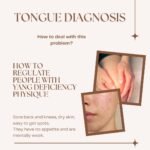
The Origins and Concepts of Tongue Diagnosis
Tongue diagnosis has a long history in China and has been highly valued by both ancient and modern practitioners of traditional Chinese medicine (TCM). Below is a brief overview of its historical development to help readers better understand and appreciate this diagnostic method.
Yin-Shang Dynasty (Approx. 1600 BCE – 1046 BCE)
According to historical records, tongue diagnosis can be traced back over 3,000 years to the Yin-Shang period. Oracle bone inscriptions unearthed at Yin ruins mention “divination of tongue ailments” in the phrase “贞疾舌,秦于妣庚,” which describes a story about King Wu Ding suffering from a tongue condition and seeking a cure through ancestral worship. This is one of the earliest written records of tongue-related medical issues.
Spring and Autumn Period to the Warring States Period (770 BCE – 221 BCE)
During this era, the Huangdi Neijing (The Yellow Emperor’s Inner Canon), the first classical text in the history of Chinese medicine, made significant contributions to tongue diagnosis. This book contains over 60 references to the tongue.
- The Lingshu section focuses on anatomical and physiological descriptions of the tongue. For example:
- The Intestines and Stomach Chapter: “The tongue weighs ten liang (a unit of weight), measures seven inches long, and is two and a half inches wide.”
- The Chapter on Worry and Silence: “The tongue is the organ responsible for sound and speech.”
- The Five Inspections and Five Movements Chapter: “The tongue is the official of the heart.”
- The Suwen section emphasizes the pathological changes in the tongue:
- The Chapter on Piercing Heat: “A person with lung heat will have a yellow coating on the tongue.”
- The Essential Theory Chapter: “In severe cases of yin exhaustion, the tongue curls, and the testicles retract, leading to death.”
Eastern Han Dynasty (25 CE – 220 CE)
In the Eastern Han period, Zhang Zhongjing’s Treatise on Cold Damage and Miscellaneous Diseases made groundbreaking observations about tongue coating. The text noted changes in tongue coating as key indicators for diagnosing yang-type and six-fu organ illnesses, while attention to tongue shape, quality, and taste was used for yin-type and five-zang organ illnesses. This work marked the first recorded use of the term “舌上胎” (tongue coating), which laid the foundation for the terminology and concepts of tongue coating in later TCM developments.
Wei and Jin Dynasties (220 CE – 420 CE)
Huangfu Mi’s Zhenjiu Jiayi Jing (Systematic Classic of Acupuncture and Moxibustion) recorded using acupuncture to treat tongue-related conditions such as sluggish tongue, double tongue, difficulty speaking, tongue swelling, tongue paralysis, and bad breath. This was the first documented use of acupuncture for tongue ailments in medical history.
Tang Dynasty (618 CE – 907 CE)
Sun Simiao’s Qianjin Yaofang (Essential Prescriptions Worth a Thousand Gold) summarized earlier medical achievements and greatly influenced the field of Chinese medicine. This text was so impactful that it spread to Japan and Korea. Its chapter “Tongue Diagnosis” pioneered specialized discussions on tongue observation.
Yuan Dynasty (1271 CE – 1368 CE)
One of the earliest surviving books on tongue diagnosis, The Golden Mirror of Cold Damage Disorders by Du Qingbi, emerged during this period. This diagnostic manual classified tongue appearances into eight categories: mild, severe, slow, urgent, deficient, excess, cold, and heat. It also expanded the original 12 tongue-coating illustrations by Ao Shun to 36, based on clinical experience. This illustrated book became a cornerstone of tongue diagnosis in Chinese medicine.
Ming and Qing Dynasties (1368 CE – 1912 CE)
During the Ming and Qing periods, the Warm Disease School emphasized the clinical application of tongue diagnosis in managing febrile illnesses.
- Early Qing physician Dai Tianzhang developed theories for distinguishing warm epidemic diseases from cold damage based on tongue appearance, building on Wu Youke’s Wenyi Lun.
- Ye Tianshi advanced tongue diagnosis by correlating tongue coating and texture with disease progression in warm diseases, integrating this with the Four Levels (wei, qi, ying, xue) and San Jiao pattern differentiation.
By this time, tongue diagnosis had become a vital, objective tool for assessing disease attributes, fluid balance, and the depth of pathogenic factors.
Modern Era
In the 20th century, the development of tongue diagnosis expanded with efforts to systematize classical texts and incorporate Western medical knowledge of anatomy and physiology. Advances in technology have further refined tongue diagnosis, with colored imaging, computer analysis, and digital storage enabling more precise clinical, educational, and research applications. Tongue diagnosis has now entered a new era of integration with modern science.

二、The Tongue Coating and Its Reflection of the Body
In traditional Chinese medicine (TCM), the tongue is generally divided into four parts: the tip, center, root, and sides. Each section corresponds to different internal organs. For example:
- The tongue tip reflects the heart and lungs. Any issues related to these organs can often be observed here.
- The center corresponds to the spleen and stomach, which are key for digestion.
- The sides are linked to the liver and gallbladder, which play a role in regulating energy and bile flow.
- The tongue root is connected to the kidneys, which in TCM represent a broader concept, covering the reproductive and endocrine systems as well as bone health.
Additionally, the veins under the tongue can show noticeable changes when there are issues with circulation.
- Tongue Root
The tongue root is associated with the kidneys. In TCM, the kidneys represent not just the organ itself but also the body’s endocrine, reproductive, and skeletal systems. Their function is reflected in urinary health, teeth, bones, and even hair.
- Tongue Center
The tongue center corresponds to the spleen and stomach. In TCM, these organs represent more than just the digestive system. They are connected to parts of the nervous system, endocrine system, immune function, and physical movement. The spleen and stomach are considered the foundation of acquired health, responsible for processing and digesting food to provide energy.
- Tongue Sides
The sides of the tongue are linked to the liver and gallbladder. These organs regulate the body’s energy flow, bile production, muscle movement, joint flexibility, and emotional balance. The liver is also closely connected to vision and nerve function, including both the central and peripheral nervous systems.
- Tongue Tip
The tongue tip is related to the heart and lungs. TCM believes the tongue is a direct reflection of the heart, with the phrase “the tongue is the sprout of the heart.” The tip specifically reveals the heart’s condition, such as excess heat, deficiency, or other imbalances. The lungs, as understood in TCM, include the respiratory system, nose, and skin.
三、What Does the Tongue Coating Reveal?
Once you have a basic understanding of tongue diagnosis, you can examine the tongue’s color, shape, flexibility, and sublingual veins to gain insight into your health.
- Tongue Color
A healthy tongue is light pink or pale red. If your tongue appears pale or white, it may indicate a deficiency in qi and blood. A darker red hue often suggests excess heat, while severe health issues may cause the tongue to turn purple or bluish. - Tongue Shape
An ideal tongue is moderate in size, thickness, and strength. When you’re unwell, the tongue may swell, show teeth marks along its edges, or develop spots, petechiae, prominent papillae, or cracks on its surface. - Tongue Flexibility
A healthy tongue moves fluidly, allowing clear speech. Illness can cause the tongue to become stiff, tremble involuntarily, or curve when extended, resulting in slurred speech or difficulty speaking. - Sublingual Veins
Two veins are visible under the tongue. In a healthy state, they may be faint or barely noticeable. When blood stagnation or poor circulation occurs, these veins become visibly pronounced and darkened.
四、How to Examine the Tongue Coating: Methods and Sequence
In tongue diagnosis, the primary focus is on visual inspection, such as examining the tongue body, coating, and veins. In addition to visual observation, it’s important to combine other diagnostic methods. For example, asking about changes in taste or any abnormal sensations on the tongue, as well as its flexibility. Listening to the clarity of speech can also provide valuable clues. Sometimes, tactile methods like palpation, pressing, or scraping are used for a more thorough examination of the tongue.
五、How Traditional Chinese Medicine Quickly Identifies Tongue Coating Issues
Why can examining the tongue reveal health problems? What exactly are we looking at when inspecting the tongue? A healthy tongue is typically “light red with a thin white coating,” appearing moist and full. If it doesn’t exhibit these characteristics, such as being too red, too pale, showing teeth marks, or having cracks, it’s considered an abnormal tongue appearance, indicating potential health issues. By analyzing the tongue’s quality, coating, texture, and pulse, we can gain detailed insights into the body’s condition. This method is highly practical for quickly understanding one’s health in daily life.
Tongue Color
Tongue color refers to the color of the tongue’s surface. It can be categorized into several shades, such as pale white, light red, red, dark red, purple, and blue. Essentially, there are two main categories:
- Pale white, light red, red, dark red: These are variations of red, ranging from light to dark.
- Purple, light purple, light blue, blue: These indicate a reduction in the red component and an increase in the blue component.
Why TCM Looks at Tongue Color for Diagnosis
Normally, the tongue color is light red, which is due to the presence of myoglobin in the muscle cells and the abundance of capillaries in the connective tissue. The blood supply is rich, and its red color is visible through the translucent tongue mucosa, giving it a light red appearance. When a person becomes ill, the composition or concentration of the blood may change, or the tongue’s mucosal layer may thicken or thin. As a result, the tongue color changes. Therefore, a healthy person typically has a light red tongue, and any other color observed on the tongue coating is often linked to the primary illness.
六、Understanding Tongue Coating to Identify Body Constitution
In daily life, people have different body constitutions due to factors such as genetics, environment, diet, and lifestyle. These differences can result in varying internal characteristics, such as cold and heat, deficiency and excess, yin and yang, dryness and dampness. This leads to different constitutions, which are reflected in the tongue’s appearance.
There are significant differences in tongue signs across various body types. Typically, there are 7 main types of tongue characteristics that help readers quickly identify their constitution and adjust their health accordingly.
Understanding Yin and Yang
The concept of Yin and Yang is an ancient Chinese philosophical theory. Yin and Yang represent opposite yet interconnected attributes of things. In terms of the body:
- The surface of the body is Yang, while the internal organs are Yin.
- The back of the body is Yang, while the front, or abdomen, is Yin.
- The five organs (heart, liver, spleen, lungs, kidneys) store essence and energy, and are Yin, while the six bowels (large and small intestines, bladder, gallbladder, stomach, and triple burner) are Yang.
Under normal circumstances, the Yin and Yang in the body remain balanced. However, when this balance is disturbed by external or internal factors, diseases can arise. In treatment, even if symptoms are the same, different methods may be used for different types of patients. For example, when treating fever, different approaches might be applied depending on the individual’s condition. Similarly, for diarrhea, different treatments are used for conditions like damp-heat or deficiency-cold. This approach is called “same disease, different treatment.” Therefore, when identifying constitution and analyzing tongue signs, understanding the balance of Yin and Yang is crucial for accurate diagnosis and treatment.
This overview provides just a brief introduction to the principles of tongue diagnosis in Traditional Chinese Medicine. For those interested in learning more, it is recommended to explore proper resources and books on the subject.




